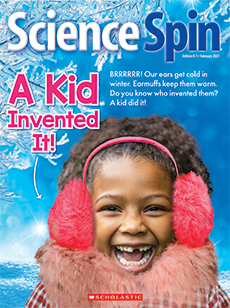October 2022
A Cute Spider?
Academic Standards
Reading Objective:
Children will identify characteristics of the tiny peacock spider, which has many eyes, jumps on food, lays eggs, and can dance!
Next Generation Science Standards:
K-LS1 Animals’ Survival Needs
1-LS1 How Animals Use External Parts to Survive
Vocabulary:
fangs
Check comprehension and inspire discussion.
1. How do these spiders see all around?
(They have eyes on the front, sides, and back of their heads.)
2. How do these spiders get food?
(They jump on it and then bite it with their fangs.)
3. Where do the spider babies come from?
(eggs)
4. Is Sparklemuffin a good name? What would you name a spider you found?
(Answers will vary.)
Go online to print or project the Reading Checkpoint.
- Peacock spiders are one type of jumping spider.
- Most peacock spiders live in Australia.
- They’re called peacock spiders because the males have bright colors like a peacock.
- The females are brown. This helps them blend into nature when they are guarding their eggs.
Materials: pencils, markers or crayons, copies of the skill sheet
Overview: Children will design a super spider with a body that can escape danger!
Directions:
- Remind students that all spiders catch food and eat it. But that’s not the whole story. Some animals, like birds, want to eat them. How do spiders protect themselves? Jumping spiders can jump away. But is that enough?
- Tell students they will invent and draw a spider that can escape any hungry bird. Start by encouraging brainstorming, either as a class or in small groups or pairs. What kind of body would this spider have that would let it escape any bird? Would it have extra jumping power, or something to protect its body from being eaten? Or would it have a way to scare off a bird?
- Students can draw and describe their super spiders on the skill sheet.
- If there’s time, students can share their super designs!
